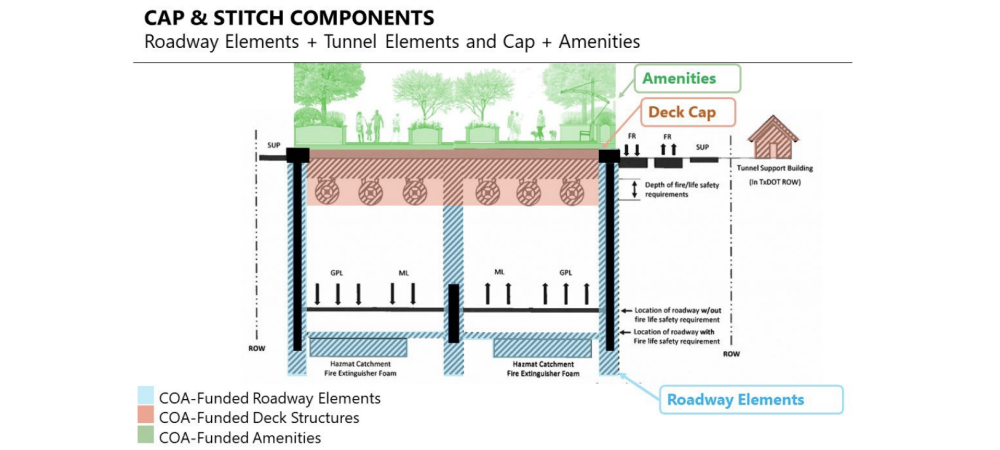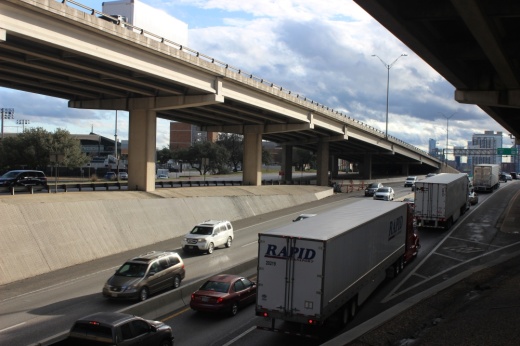The big picture
As TxDOT moves toward construction of Capital Express Central—the multiyear, multibillion dollar expansion of I-35 through 8 miles of Central Austin—local leaders are seeking to enhance the project with new public spaces covering the highway.
Austin’s Our Future 35 program aims to build a series of caps and stitches, or decks, serving as improved east-west connections atop portions of the interstate that would feature new amenities and structures. The city’s cap and stitch projects would be in addition to smaller highway crossings included in TxDOT's Capital Express.

While TxDOT is leaving room for the caps and stitches dozens of feet above the lowered I-35 roadway, the city and UT will foot the bill for designing, building and maintaining their own structures.
University spokesperson Meredith Pruitt said architecture firm SOM will be providing planning and design recommendations, and an estimated project budget, to UT this spring.
"This is a transformational opportunity for UT Austin to connect west and east campus, enrich the medical district development, expand open, outdoor gathering spaces, and bolster parks and recreation for the Greater Austin community," Pruitt said in an email. "The project could also create multiple opportunities for improvements in areas adjacent to university land, and we look forward to sharing further details with the public once they are finalized.”
On Austin's side, City Council and transportation staff continue to evaluate a range of options for covering the cap costs.
By the numbers
Development of the city's caps and stitches is now estimated at around $868 million, most of which still has yet to be secured.
TxDOT’s deadlines for including cap and stitch projects in its overall I-35 plan are now drawing closer. By the end of 2024, Austin must line up:
- $34 million for roadway and deck designs, $15 million of which has already been committed
- $174 million for roadway construction
- Concepts for $342 million of possible amenities, to be funded later
The outlook
Deputy CFO Kim Olivares told council March 19 that a single type of funding will "absolutely not" cover the city's requirements, with federal, state, local and private support needed.
Making a major dent in the program totals, the city won $105.2 million from the U.S. Department of Transportation in March for the largest of its planned caps spanning 5.28 acres from Cesar Chavez to Fourth streets. That federal award comes with the requirement that Austin provide a local match of $45 million.
To further fill out the city’s funding gap, council voted March 21 to pursue a $191 million loan from TxDOT’s State Infrastructure Bank for this year's remaining $19 million in design work and $172 million for roadway and deck development.
Transportation Director Richard Mendoza said the city should know whether it's getting those state dollars by late summer or early fall. Similar to city bonds, the state loan would be repaid through city property taxes over 20 years at an expected 3.75% interest rate, totaling about $83.9 million in interest.
Looking ahead, staff said Austin voters will likely be asked to support a large portion of Our Future 35 needs in a November 2026 bond election, potentially for hundreds of millions in new transportation dollars.
If voters rejected that measure, city staff said future deck funding opportunities could take place in 2032 and 2042.
Other options under consideration include:
- Public-private partnerships that could result in developments atop the caps
- Philanthropic collaborations, such as donations, naming rights for structures
- Leasing land on the decks
- Tax increment financing, or capturing added future property value on caps through city tax collections
- New civic fees charged to Austinites or event fees for programming on caps
Staff said they continue to evaluate all possible financing strategies moving forward.
“The landscape has continued to change in a good way as it comes to the cap and stitch," Olivares said. "We received the $105 million grant ... and we continue to have really great conversations with TxDOT that help us in terms of shaping what funding options would be best for the various components of this project.”
What's next
With a clearer picture of Austin's cap and stitch program, transportation planners will now take the latest Our Future 35 framework into the community over the coming months.
City staff said they'll be hosting public open houses and other feedback sessions through the spring and summer before arriving at next steps for the projects in the fall. New input could help shape the amenities that end up on the highway decks, the order the structures are built in, and other early details.
Further council review would take place before those outlines are cemented and the city's 2024 payments to TxDOT are finalized in December.
For now, Watson also emphasized TxDOT's cooperation with Austin as the cap and stitch plans come together.
“They have signaled to us a willingness to entertain a much bigger opportunity here," he said. "That is consistent, I think, with having the kind of relationship that we want to have with the state government so that we can partner on projects like this, and I just want to say to them thank you for taking that position."





